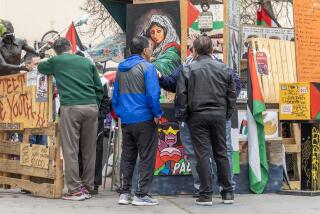CSUN Says ‘Happy 40th’ to Pioneering Professors
- Share via
Forty years ago, the college that eventually became California State University Northridge consisted of eight temporary buildings, 40 professors and 80 or so students. That was it. There was no football field. No quad. Not even a paved road.
But at a 40th birthday party for those first professors at CSUN Sunday, some of the pioneers joked that despite the addition of dozens of buildings, sports fields and student housing on the now-sprawling campus, the school hasn’t changed much.
“Once upon a time, there was a squash field here on campus,” Frank St. Denis, one of the early students, told a group of 120 people who gathered for a champagne brunch at the school’s University Club. “I know, because I parked in it on the first day I came to school here. I came here today to park in it again, but now it is paved.”
He paused.
“Then I saw the trailers and I felt right at home.”
They came to talk about how the school rebounded after the 1994 Northridge earthquake, to share 40-year-old stories they all knew by heart and reminisce about building a university from scratch.
“There was the feeling that this was our place,” said William Schlosser, who taught theater and is now retired. “There was great camaraderie, and everybody wanted to make a go of this thing.”
Organizers said all 28 of the original professors still living showed up Sunday.
On the first day of classes in 1956, the school was called the San Fernando Valley campus of Los Angeles State College. Two years later, it became a college in its own right and was rechristened San Fernando Valley State College. And finally, in 1972, the school’s name was changed again, this time to California State University Northridge.
*
Julian Nava, a former U.S. ambassador to Mexico and probably the most famous of the professors, was 29 when the school opened.
He had graduated from Harvard University and was looking for work when a university in Nebraska offered him a teaching job if he agreed not to “curse, smoke or fornicate in town,” he said. He turned the job down and came to Northridge.
Although they joked about it, many of the professors said they believed they were chosen to teach at CSUN because they were regarded as troublemakers elsewhere in the Cal State system.
Some volunteered; some said they were “urged” to write letters asking for a transfer.
“They called us the Australia of the Cal State system because this is where they sent the troublemakers,” said Malcolm Sillars, a speech professor, now retired.
Most of the professors were relatively young--in their 30s and early 40s--and had served in World War II, gone to college on the GI Bill and had had only one or two previous teaching posts.
Being at Northridge at that time gave them a chance for hands-on experience they would not have otherwise had. For instance, they urged the school’s architect not to design big lecture halls because they favored small classes.
“We felt there should be a personal relationship between student and professor,” explained Schlosser.
There are still no large lecture halls on the campus--only one of the accomplishments for which the group will be remembered.
“There is no better evidence of your legacy than the way students, faculty and staff gathered after the earthquake,” said Blenda Wilson, the school’s president. “At the time, I think it was Bill [Schlosser] who said, ‘Don’t fret about the trailers, this school started as trailers. Education can happen there.’
“He was right.”
More to Read
Sign up for Essential California
The most important California stories and recommendations in your inbox every morning.
You may occasionally receive promotional content from the Los Angeles Times.













